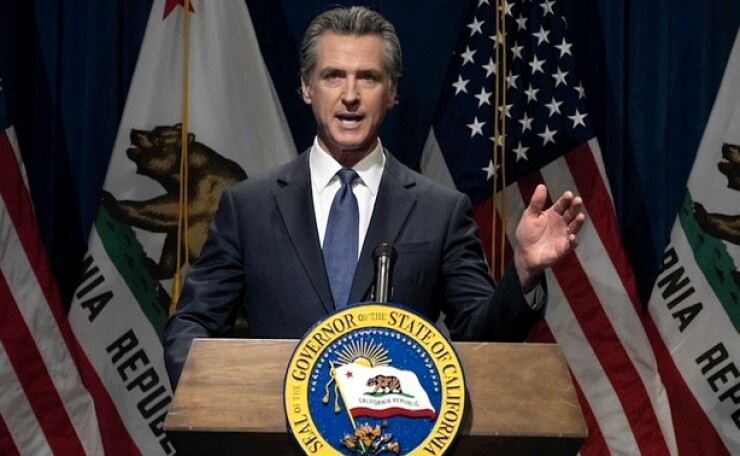California governor says budget must close $38 billion deficit
6 min read

California’s budget shortfall is $30 billion less than the $68 billion deficit forecast by the legislative analyst’s office in November, Gov. Gavin Newsom said Wednesday as he unveiled his proposed $291.5 billion budget for fiscal year 2024-25.
Even his estimated $37.9 billion deficit will still require some tough choices as Newsom and lawmakers work on the budget, including, Newsom said, the possibility he may announce a fiscal emergency if he needs to tap reserves as proposed in his budget.
Newsom’s initial budget proposal assumes $15 billion more in revenues
“Due to the federal tax deadline delays and California’s subsequent conformity, the majority of the state’s revenues did not arrive until October and November,” Newsom said. “That means the correction that would have come as part of last year’s May Revision is instead being made in this January budget.”
The state has what Newsom called a record-setting $38 billion in reserves that it set aside to guard against this possibility when the fiscal 2023-24 budget was passed July 1.
Newsom called the budget and this year’s revenue forecast a “correction and return to normalcy, after a period of distortion,” pointing to the massive
“The big three revenues are projected to revert to levels consistent with a normal revenue growth trajectory, absent the COVID-19 surge and subsequent correction,” he said.
To close the deficit, Newsom proposed drawing down $13.1 billion from three reserve accounts, $8.5 billion in budget cuts including $2.9 billion to climate programs, $1.2 billion to housing programs, $762.5 million by not filling vacant positions, $500 million from the state school facilities aid program, $494 million from the student housing revolving loan fund program, $350 million in legislative requests, $300 million from the University of California Los Angeles Institute of Immunology and Immunotherapy and $289 million from the middle class scholarship program.
His budget would use $1.3 billion from Proposition 2 debt repayment funding to reduce the state’s pension liability, rather than money from the general fund; and also use $1.8 billion from the Greenhouse Gas Reduction Fund, rather than tapping the general fund for programs.
It would also defer $1.6 billion in payroll obligations from June 2024 to July, pushing the costs into the next budget year, and defer $273.3 million in funding for the University of California system and $240 million for the California State University systems.
“We are deferring, but not delaying, which will allow UC and CSU to borrow against that,” Newsom said. “We want to reinforce the universities are in a position to advance those dollars.”
Closing the budget gap would also involve revenue and internal borrowing including increasing the Managed Care Organization Tax Support for Medi-Cal, the state’s Medicaid program, by $3.8 billion.
About 70% of the budget’s spending would go toward public schools, colleges and health and social services. Newsom said he wanted to protect investments in addressing homelessness, mental health reform and public safety. He added that $10 billion in funding from the federal government would help him to continue to fund his climate-related programs.
“I look forward to engaging and working with the Legislature as we move forward to the May revise,” Newsom said. “We will be able to do it with the kind of clarity that we did not have last year.”
Newsom’s proposal to pause funding to implement newly signed laws received immediate blowback from senators Scott Wiener, D-San Francisco and Henry Stern, D-Los Angeles, the authors of two laws that are part of The Climate Accountability Package.
The funding pause means that the $3 million needed by the California Air Resources Board to start work crafting regulations that would hold corporations accountable for emissions would only come through if they make it back into the budget during the May revise.
“The global community is looking to California for a firm commitment to implementing our bold climate agenda, especially these world-leading climate action laws,” Wiener said, urging Newsom to include funding in his May budget revisions.
Under SB 253, authored by Wiener and signed by Newsom in October, corporations with gross annual revenue over $1 billion that do business in California must begin disclosing their greenhouse gas emissions by 2026. Before the companies can file, CARB must establish rules that govern details of the disclosures, a process that can take 18 months or more.
Under SB 261, introduced by Stern and signed by Newsom, corporations with gross annual revenue over $500 million that do business in California must disclose their climate-related risk.
State Controller Malia Cohen said as she released the state’s cash report Wednesday that lawmakers and the governor will “have a difficult task ahead to bring revenues and spending into balance in the year ahead.”
The monthly cash report showed December’s cash position short of the DOF Budget Act cash flow estimates for fiscal year 2023-24 by $3 billion.
“Lawmakers forethought in building rainy-day reserves in the Budget Stabilization Account has bolstered the state’s cash-on-hand and provides stability in the face of a budgetary deficit,” Cohen said.
The state has $88.5 billion in available borrowable resources, Cohen said, adding that barring any unforeseen circumstances, the state still has ample cash in its coffers to pay its bills and meet its financial obligations through the end of the fiscal year.
December saw California’s total General Fund receipts fall $5.2 billion, or 21.4% short of estimates for the month, while disbursements were $2.3 billion, or 10.1% lower than estimated, according to the controller’s cash report. The state is 22.2% behind forecasts for the fiscal year to date with general fund receipts coming in $28.2 billion below estimates.
State Treasurer Fiona Ma called the governor’s budget “prudent and responsible,” adding that she was pleased to see that the governor’s shortfall numbers were much lower than the LAOs, and that he preserved funding for critical programs and services like climate change, education and small business initiatives.
“It’s also important to put the circumstances surrounding the deficit in context,” Ma said. “Compared to previous deficits, the state and federal macro-economic indicators are strong, and California maintains ample cash resources to draw upon if needed. We are much better situated to withstand this deficit with minimal impact to state government operations.”
On Tuesday, Newsom announced a new infrastructure dashboard that he described in more detail during the Wednesday media briefing on the budget. He also spent last week advocating for a March bond measure to support his proposed overhaul of the state’s mental health system to help alleviate the state’s homelessness crisis.
The
Newsom’s new website outlines how $180 billion the state plans to spend on infrastructure over the next 10 years will help tackle climate change, equity and provide jobs.
The website will not only track where the money is being spent, but showcase how individual projects impact the communities they are in, Newsom said.
“Where are my tax dollars going? It’s a question I get all the time. We try to answer that with this website,” Newsom said. “It’s not perfect, we just rolled it out. It’s a big first step. We want to start doing this across the board. If there is a theme for this year, it’s accountability.”
He signed legislation last year to accelerate critical infrastructure projects across the state that will help build a 100% clean electric grid, strengthen the state’s water resiliency and boost water supply, and modernize our transportation system.
He also established an Infrastructure Strike Team through an executive order in May to implement an all-of-government strategy to fast-track infrastructure projects and remove barriers to project development.
Last week, Newsom held a press conference in Los Angeles to urge support of Proposition 1, a $6.4 billion state bond measure to provide new behavioral health beds and overhaul the state’s Mental Health Services Act.
The measure, slated for the March 5 ballot, would reform the Mental Health Services Act, approved by voters in 2004 that established a 1% tax on personal income above $1 million per year to fund county mental health services.
Proposition 1 would divert 30% of that funding, or about $1 billion a year, toward supportive housing for people with severe mental illness or substance use disorders.
Lawmakers voted in September to place Newsom’s plan on the ballot.







